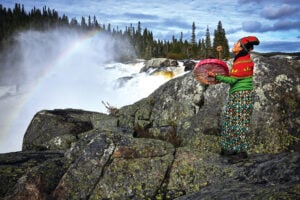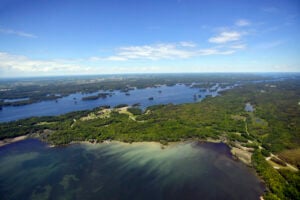Boldt Castle, Heart Island, N.Y.
The Thousand Islands have thousands of stories to tell, but perhaps none of them is as romantically compelling as that of Boldt Castle, the Rhineland-style pile that occupies Heart Island, near Alexandria Bay, N.Y.
The brainchild of George C. Boldt, a German immigrant who became a wealthy hotelier in Philadelphia and New York City, the castle was meant to be a paean to his wife, Louise. Money was no object, and starting in 1900 about 300 workers set to building the six-storey, 120-room structure, which was meant to include tunnels, a drawbridge and gardens, among other features. In January 1904, however, with the castle incomplete, workers received a telegram from Boldt, commanding them to stop construction. The reason? Louise had died.
Unable to consider continuing the project without its raison d’etre, a shattered Boldt abandoned his plan. The castle stood empty for more than 70 years, a victim of the elements and vandalism, until the Thousand Island Bridge Authority acquired the property in 1977. Since then, the authority has poured millions of dollars into restoring the castle to Boldt’s original vision. Today, it’s a hugely popular attraction that every year sees thousands wander through its grounds and rooms, which include a ballroom, billiards room, grand hallway, library and George Boldt’s bedroom.
Millionaire’s Row, near Alexandria Bay, N.Y.
George Boldt wasn’t the only wealthy American who fell in love with the St. Lawrence River. Other, arguably more famous people — businessman John Jacob Astor IV and railway magnate George Pullman, for instance — also flocked to the river, building grand homes on several of the Thousand Islands in the vicinity of Alexandria Bay, N.Y. Today, this series of residences is known as Millionaire’s Row.
Astor had a home built at the foot of Cherry Island, as did cosmetics entrepreneur Helena Rubinstein, while Pullman’s Castle Rest on Pullman Island (yes, he renamed it after himself) was renowned for its grandiosity, with a six-storey tower and 58 rooms. The castle was demolished in the 1950s, but the island and its remaining buildings still draw plenty of visitors.
Iroquois dam and lock, Iroquois, Ont.
Its exposed surface may not look like much, but the Iroquois dam, at Iroquois, Ont., is a significant piece of engineering. At 805 metres long, 58.5 metres thick at its base and 27 metres high, it acts as the control dam for Lake Ontario, regulating the flow of water from the lake into the rest of the river. Vessels can bypass the dam through the adjacent Iroquois lock, the lift of which varies between 0.6 metres and 1.8 metres.
Soulanges Canal, near Coteau-Landing, Que.
Although it’s no longer in use, the Soulanges Canal has a storied history. Constructed between 1892 and 1899, it allowed vessels to skirt rapids in the St. Lawrence River by travelling through five locks along its 23-kilometre length, passing from the river’s Lake Saint-Louis to Lake St- François. The river drops about 25 metres between the latter and the former. The canal closed in 1958, when the Beauharnois Canal, which later became part of the St. Lawrence Seaway, opened. It has been suggested that the Soulanges Canal could one day be reopened for pleasure craft, but until that happens, the best way to experience the waterway is by biking or walking the trail that runs alongside most of its length.






